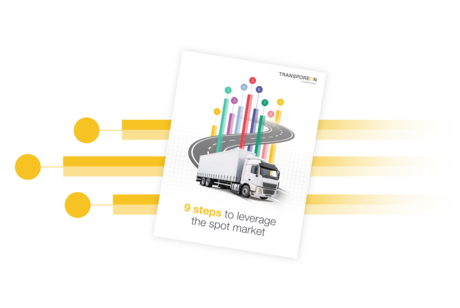1. Understanding contract freight vs. spot freight
Around 85% of truckload freight is contracted freight, established via annual bids and RFPs for projected volumes on specific lanes. While offering stability, the challenges of unforeseen events can lead to above-market rates during soft market conditions. In contrast, spot freight, encompassing non-contractual transactions, provides agility and is advantageous for surge volume orders, shipments with inconsistent patterns and rejected freight. When used strategically, spot freight is an efficient way to secure competitive rates, optimize backhauls and enhance market efficiency.
2. Understanding the state of the spot market, challenges and benefits
The freight market's dynamic nature, driven by supply, demand and shipping capacity, poses challenges, especially in the spot market. These challenges include shifts in demand patterns, an aging trucking workforce, equipment shortages and inflation. However, the spot market also has many benefits, including handling exceptions, finding capacity at competitive rates, expanding carrier networks, building mutually beneficial relationships with partners, using backhauls, and improving overall industry efficiency. Effectively managing spot freight demands real-time market insights, negotiation skills and the ability to leverage digital tools.
3. Understanding how spot rates are composed
Spot freight rates fluctuate daily, based on the real-time balance of supply and demand in the truckload market. Factors like lane characteristics, commodity types, market conditions and timing (lead time, days of the week, time of the day and dwell time) impact spot rates significantly.
While the majority of shippers mostly use the spot market for tender rejections (leading to higher operational and financial impact), strategic use of the spot market allows shippers to find capacity at better rates and enhance competitiveness. Thorough preparation and comparing quotes are essential for effective rate analysis in this dynamic environment.
4. Apply a portfolio approach to freight procurement and avoid ‘ghost lanes’
To reduce costs, optimize operations, and improve carrier relationships, shippers should apply a portfolio approach to procurement and assignment. This approach involves incorporating different kinds of contracts, with a strategic focus on the spot market that includes more attractive and well-timed lanes. While contracts provide stability, their non-binding nature and post-pandemic market volatility can lead to inefficiencies and higher costs. Ghost lanes – contract lanes where demand rarely materializes – incur significant upfront costs for shippers and carriers. Shifting from fixed-price contracts to a more flexible, wait-and-see approach enhances strategic use of the spot market, fostering better assessments and competitive pricing.
5. Create and maintain a healthy pool of carriers on the spot market
It makes sense to devote a significant proportion of your procured lanes to your contracted carriers. However, not all shipments are fit for contracts. Therefore, having a healthy pool of carriers on the spot market is crucial for finding capacity at competitive prices, whatever the market dynamics. Maintain a healthy carrier pool by securing contracts for lanes that align with your carrier network, while honoring your contractual commitments. Use the spot market strategically to challenge contracted rates from time to time, offer attractive spot transports, prioritize timely requests and facilitate flexible matchmaking. Performance analysis and effective communication, to understand which lanes fit your major carriers' network, lead to cost and overall market efficiency.
6. Use lane segmentation and put a variety of attracting lanes on spot
The key consideration for choosing between contract and spot markets lies in understanding the operational dynamics from the carrier's perspective. The ideal factors for segmenting and assigning freight to the spot market are the types of freight that pose challenges for carriers. These include urgent shipments, sudden volume surges, and shipments on new or more challenging lanes. Lead time influences costs, with rushed shipments costing 30-35% more than contract prices, prompting shippers to optimize processes or explore the spot market. Become a shipper of choice for both contracted and spot carriers by offering the same yard experience with easy facility processes and low detention times.
7. Use a smart transport assignment tool to assign your spot loads
To leverage the spot market, shippers need more than a good strategy – they need advanced tools. A holistic Transportation Management Platform, powered by an integrated network of carriers and logistic service providers, along with rule-based and data-driven automation, is essential for securing capacity at competitive rates on the spot market. Incorporating functionalities like price prediction and benchmarking, load visibility, carrier communication, exception handling, and integration with other transport functions, such as dock scheduling, empowers shippers to strategically leverage the spot market. This not only enhances operational efficiency, but also contributes to overall cost-effectiveness.
8. Leverage automation, AI, machine learning and behavioral science
AI revolutionizes spot freight management by leveraging machine learning for predictive pricing and autonomous spot procurement and assignment. Unlike traditional methods, AI analyzes both historical data and human behavior in real-time, offering customized spot rates based on carrier profiles.
Autonomous Procurement, an AI-powered approach, replaces bid systems with instant, differentiated and tailored offers for each carrier/load. This reduces tender rejections, ensuring quick matches, and fostering deeper relationships between shippers and carriers. This dynamic solution enhances efficiency and cost-savings in spot freight market procurement and assignment.
9. Collaborate with your carrier partners
Shippers and carriers recognize the need for collaboration and are moving away from an adversarial mindset. Leveraging transportation management platforms can facilitate effective communication, by connecting both parties on a unified platform. This leads to mutually beneficial outcomes, such as overall industry efficiency, optimizing backhaul opportunities and reducing empty miles.
Transportation management platforms also allow shippers and carriers to share data and enjoy end-to-end visibility, enabling informed conversations that set realistic expectations and promote mutual accountability. Digital platforms also foster collaboration to address industry challenges, such as capacity and labor shortages, allowing carriers to streamline allocation processes and identify shippers receiving capacity
In conclusion:
Spot should happen, but it needs to be strategically planned and effectively executed to optimize your logistics operations, supply chain and business outcomes.
Understanding the contrast between contract and spot freight is vital for effective logistics management. Contract freight provides stability, while strategic spot freight offers flexibility and potential cost savings. Knowledge of spot market dynamics and rate determinants facilitates informed decision-making. Adopting a portfolio approach, segmenting lanes and using technology-driven solutions enhance procurement efficiency.
Leveraging transportation management platforms with smart tools, automation and carrier collaboration helps to optimize load assignments, increase operational efficiency and drive cost savings. All of this positively impacts your business’s bottom line and helps you achieve your commercial goals.







